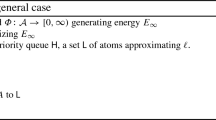Abstract
In this paper, we propose a novel framework, called Dinkelbach NCUT (DNCUT), which efficiently solves the normalized graph cut (NCUT) problem under general, convex constraints, as well as, under given priors on the nodes of the graph. Current NCUT methods use generalized eigen-decomposition, which poses computational issues especially for large graphs, and can only handle linear equality constraints. By using an augmented graph and the iterative Dinkelbach method for fractional programming (FP), we formulate the DNCUT framework to efficiently solve the NCUT problem under general convex constraints and given data priors. In this framework, the initial problem is converted into a sequence of simpler sub-problems (i.e. convex, quadratic programs (QP’s) subject to convex constraints). The complexity of finding a global solution for each sub-problem depends on the complexity of the constraints, the convexity of the cost function, and the chosen initialization. However, we derive an initialization, which guarantees that each sub-problem is a convex QP that can be solved by available convex programming techniques. We apply this framework to the special case of linear constraints, where the solution is obtained by solving a sequence of sparse linear systems using the conjugate gradient method. We validate DNCUT by performing binary segmentation on real images both with and without linear/nonlinear constraints, as well as, multi-class segmentation. When possible, we compare DNCUT to other NCUT methods, in terms of segmentation performance and computational efficiency. Even though the new formulation is applied to the problem of spectral graph-based, low-level image segmentation, it can be directly applied to other applications (e.g. clustering).
Similar content being viewed by others
References
Bhatia, R. (1997). Matrix analysis. Berlin: Springer.
Boykov, Y. Y., & Jolly, M. P. (2001). Interactive graph cuts for optimal boundary & region segmentation of objects in n-d images. In International conference on computer vision (Vol. 1, pp. 105–112).
Boykov, Y., & Funka-Lea, G. (2006). Graph cuts and efficient n-d image segmentation. International Journal of Computer Vision, 70(2), 109–131.
Boykov, Y., Veksler, O., & Zabih, R. (2001). Fast approximate energy minimization via graph cuts. Transactions on Pattern Analysis and Machine Intelligence, 23(11), 1222–1239.
Cour, T., & Shi, J. (2007). Solving Markov random fields with spectral relaxation. In International conference on artificial intelligence and statistics (Vol. 11).
Cour, T., Benezit, F., & Shi, J. (2005). Spectral segmentation with multiscale graph decomposition. In International conference on computer vision and pattern recognition (pp. 1124–1131).
Dinkelbach, W. (1967). On nonlinear fractional programming. Management Science, 13, 492–498.
Eriksson, A. P., Olsson, C., & Kahl, F. (2007). Normalized cuts revisited: a reformulation for segmentation with linear grouping constraints. In International conference on computer vision.
Georgescu, B., Shimshoni, I., & Meer, P. (2003). Mean shift based clustering in high dimensions: a texture classification example. In International conference on computer vision (Vol. 1, pp. 456–463).
Greig, D., Porteous, B., & Seheult, A. (1989). Exact maximum a posteriori estimation for binary images. Journal of the Royal Statistical Society, 51, 271–279.
Kolmogorov, V., Boykov, Y., & Rother, C. (2007). Applications of parametric maxflow in computer vision. In International conference on computer vision.
Lehoucq, R. B., & Sorensen, D. C. (1996). Deflation techniques for an implicitly restarted Arnoldi iteration. SIAM Journal on Matrix Analysis and Applications, 17, 789–821.
Li, Y., Sun, J., Tang, C. K., & Shum, H. Y. (2004). Lazy snapping. In SIGGRAPH’04: ACM SIGGRAPH 2004 papers, New York, NY, USA (pp. 303–308). New York: ACM.
Malik, J., Belongie, S., Leung, T. K., & Shi, J. (2001). Contour and texture analysis for image segmentation. International Journal of Computer Vision, 43(1), 7–27.
Martin, D., Fowlkes, C., Tal, D., & Malik, J. (2001). A database of human segmented natural images and its application to evaluating segmentation algorithms and measuring ecological statistics. In International conference on computer vision (pp. 416–423).
Paragios, N., Chen, Y., & Faugeras, O. (2006). The handbook of mathematical models in computer vision (pp. 100–119). Berlin: Springer.
Pardalos, P. M., & Vavasis, S. A. (2004). Quadratic programming with one negative eigenvalue is NP-hard. Journal of Global Optimization, 1(1), 15–22.
Pothen, A., Simon, H. D., & Liou, K. P. (1990). Partitioning sparse matrices with eigenvectors of graphs. SIAM Journal on Matrix Analysis and Applications, 11, 430–452.
Rodenas, R., Lopez, M., & Verastegui, D. (1999). Extensions of Dinkelbach’s algorithm for solving non-linear fractional programming problems. TOP: Journal of the Spanish Society of Statistics and Operations Research, 7(1), 33–70.
Rother, C., Kolmogorov, V., & Blake, A. (2004). “GrabCut”: interactive foreground extraction using iterated graph cuts. ACM Transactions on Graphics, 23(3), 309–314.
Shi, J., & Malik, J. (2000). Normalized cuts and image segmentation. Transactions on Pattern Analysis and Machine Intelligence, 22, 888–905.
Thompson, R. C., & Freede, L. J. (1970). Eigenvalues of partitioned hermitian matrices. Bulletin of the Australian Mathematical Society, 3, 23–37.
Weiss, Y. (1999). Segmentation using eigenvectors: a unifying view. In International conference on computer vision (pp. 975–982).
Yu, S., & Shi, J. (2004). Segmentation given partial grouping constraints. Transactions on Pattern Analysis and Machine Intelligence, 2(26), 173–183.
Author information
Authors and Affiliations
Corresponding author
Rights and permissions
About this article
Cite this article
Ghanem, B., Ahuja, N. Dinkelbach NCUT: An Efficient Framework for Solving Normalized Cuts Problems with Priors and Convex Constraints. Int J Comput Vis 89, 40–55 (2010). https://doi.org/10.1007/s11263-010-0321-2
Received:
Accepted:
Published:
Issue Date:
DOI: https://doi.org/10.1007/s11263-010-0321-2




